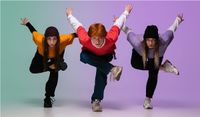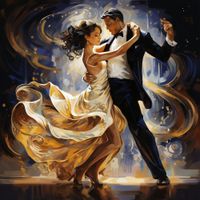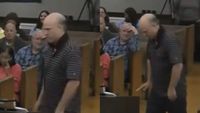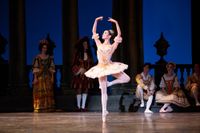Explore web search results related to this domain and discover relevant information.

Learn about and revise the essential skills and teaching points of dance in this BBC Bitesize GCSE PE study guide.
All dances require different types of turns, on different levels and sometimes around different axes.These essential skills and step-by-step resources will explain the techniques required to successfully perform a range of dance movements.Turning on the spot, turning in the move, turning in the air, turning to change direction, turning around different axes, turning on different body parts, turning in different shapes, turning around something, turning with a partner or group, turning with a prop.Changing the type of turn, turning in different shapes through the air, changing the speed of turn, changing the direction of turn, timing of the turn to coordinate with music, partner or group, thinking about how you can link different turns together.
Turn technique—learn about ten types of turns in less than five minutes.
Home | About Us | Quality | Ordering | FAQs | Contact | View Cart or Checkout Latin Dances | DVD Dance Videos | Hollywood Dance Movies | Learning Center | Dance Music Dancer's Dictionary | Complete Catalog | Site Map
Answer (1 of 2): Turn out is how your feet look when in first position. There are a wide range of opinions on how much you should be turned out; it depends on the style of ballet you are trained in, your teacher, the company youre dancing with and the type of turnout they prefer, and much much m...
Answer (1 of 2): Turn out is how your feet look when in first position. There are a wide range of opinions on how much you should be turned out; it depends on the style of ballet you are trained in, your teacher, the company you’re dancing with and the type of turnout they prefer, and much much m...

Share your videos with friends, family, and the world

In the enchanting world of Ballroom and Latin American dancing, turns emerge as the stars of the show, weaving an intricate tapestry of charm and sophistication.Turns, both a science and an art, play a pivotal role (excuse the pun!) in elevating the dance experience to a realm of sheer delight.
Embark on a dance journey where every step is a manifestation of grace and every twirl is a delightful expression of rhythm. In the enchanting world of Ballroom and Latin American dancing, turns emerge as the stars of the show, weaving an intricate tapestry of charm and sophistication.Turns, both a science and an art, play a pivotal role (excuse the pun!) in elevating the dance experience to a realm of sheer delight.Turns, both a science and an art, play a pivotal role (excuse the pun!) in elevating the dance experience to a realm of sheer delight. Picture the dance floor as a dynamic playground, where partners seamlessly navigate through a series of turns — each revolution adding a layer of elegance and finesse to the performance.Can you imagine a dance where the dancer only moves in straight lines? At the heart of this rhythmic ballet are turns like natural and reverse turns, lending a touch of classic allure to dances such as Waltz and Foxtrot.Spins and spirals inject an element of excitement, transforming the dance floor into a canvas where partners paint with the colours of energy and intensity. The true beauty of mastering turns lies in the ability to unlock the secrets of precision and elegance.

The festival opener “Nôt,” from Marlene Monteiro Freitas, drew both boos and applause. Elsewhere, for Anne Teresa De Keersmaeker, the spectacle was kept to the stage.
It may not have matched the most electric dance nights at the Cour d’Honneur — including the 1960s breakthrough of the neoclassical choreographer Maurice Béjart, and visits by Pina Bausch — but Freitas deserves to return. Another choreographer who’s had a star turn on that stage is Anne Teresa De Keersmaeker, whose 2011 work at the festival, “Cesena,” was timed to accompany sunrise, with performances starting at 4:30 a.m.De Keersmaeker dances the first few songs alone, with her much younger partner shouting a few Brel lines from a higher point in the Boulbon quarry, where the show is staged. When he joins her onstage, he slips into her trademark moves, like pared-down turns with arms outstretched.Not this year. For the first time since 2011, dance took center stage on the festival’s biggest night: the opening performance in the monumental Cour d’Honneur, the open-air courtyard of the city’s Papal Palace.Tembe commands the stage, moving her chiffon legs with pointed staccato defiance, folding and unfolding them not unlike the puppets in another Stravinsky ballet, “Petrushka,” while her proud shoulders hint at Russian folk dancing.

A town hall meeting in New Jersey took an unexpected turn when a local man kicked off his speech with a breakdancing performance, leaving attendees both stunned and amused. The man, identified as Will Thilly, is running as an independent candidate for the Cranford Township Committee. In a now-viral video, Thilly can be seen approaching the podium but stopping midway to break into an elaborate dance ...
A town hall meeting in New Jersey took an unexpected turn when a local man kicked off his speech with a breakdancing performance, leaving attendees both stunned and amused. The man, identified as Will Thilly, is running as an independent candidate for the Cranford Township Committee. In a now-viral video, Thilly can be seen approaching the podium but stopping midway to break into an elaborate dance routine.After his dance, Thilly shifted gears and began speaking, first casually asking about everyone’s weekend and mentioning a recent trip to Mexico, before addressing a serious local issue, rising property taxes, ABC News reported.Mayor Terrence Curran, who was presiding over the meeting, responded with a chuckle, saying, “Thank you, Mr. Thilly. I like the interpretive dance.”“I'm dead the only thing that sucked was the guy at the end calling it an interpretive dance,” the fourth wrote on X.
Hey y’all. Turns are something I’ve always struggled with. I’ve asked so many teachers for advice and nothing seems to work. I can hold a balance for…
It could be the preparation, coordination, turning position, or landing—numerous factors affect turns. I suggest recording yourself to evaluate your single pirouette. Once you identify the issue, you can ask more specific questions. Reply · reply · Top 2% Rank by size · r/Dance • ·r/Dance · We support any protests against Reddit being an ass about API pricing. While we're thinking what to do, consider heading over to lemmy.ml to create new communities not limited by corporate greed. Members · Online • · Responsible-Wait2619 · ADMIN MOD · Discussion · Hey y’all. Turns are something I’ve always struggled with.Posted by u/Responsible-Wait2619 - 6 votes and 6 commentsA community for ballet dancers and enthusiasts.

Turns are complex movements that rely on the coordinated effort of the entire body. Each body part plays a crucial role in ensuring the turn is balanced, smooth, and controlled. Let’s explore how each part contributes: The core is the foundation of all dance movements, and turns are no exception.
A strong core provides the necessary stability and balance, allowing dancers to control their movement while spinning. When the core muscles (abdominals, obliques, and lower back) are engaged, the dancer can maintain an upright posture, keeping the body aligned and preventing wobbling or falling off balance during the turn.For turns like chaînés or fouettés, the arms help initiate and control the movement. The momentum from arm rotation can help propel the turn, while correct positioning helps maintain balance. Incorrect arm placement can cause the dancer to twist or lose alignment, throwing the turn off-center.The hips are responsible for alignment and mobility in turns. Keeping the pelvis level and squared is key for preventing over-rotation or imbalance. The hips must remain stable while the dancer rotates, particularly during one-legged turns like pirouettes.The working leg (the leg that comes into passé or another position during the turn) must also be positioned correctly to prevent loss of balance. Dancers should focus on keeping their supporting leg strong and straight, and their working leg in proper alignment to maintain control.

A community for ballet dancers and enthusiasts. On mobile click on 'see more'⬇️ to access the Side 'Barre ' and learn more ... The sport where you strap two boards to your feet and point them down the mountain. Turning optional!
It’s never to late to learn to dance. But to do those turns you need to work your as off for years. No way anyone can do that without proper technique and foundation, but if you invest good time into dance you’ll get it no doubt.A community for ballet dancers and enthusiasts. On mobile click on 'see more'⬇️ to access the Side 'Barre ' and learn more ... The sport where you strap two boards to your feet and point them down the mountain. Turning optional!And is your goal solely to do lots of turns? The reason I ask is that multiple turns build on other unorganised dance fundamentals (e.what am i supposed to work on if my goal is to be able to do that many turns? Share ... It's all about the building blocks. It's never too late to start, but to learn how to dance is always easier with a teacher

Answer (1 of 3): The primary things to do are to keep practicing and ask your instructor for feedback. Not everyone is going to struggle with the same issues. Some general tips: Make sure that you spot. Find a point on the upper wall of where you're going/facing your “audience” and make ...
Answer (1 of 3): The primary things to do are to keep practicing and ask your instructor for feedback. Not everyone is going to struggle with the same issues. Some general tips: Make sure that you spot. Find a point on the upper wall of where you're going/facing your “audience” and make sure th...


'Ishq Hai' is an iconic track for Netflix's Mismatched season three. Craig David and Armin van Buuren transformed it into an energetic anthem.
Cricketer David Warner & Daughter dance to ‘Sheila Ki Jawani’ · Entrepreneurs turn Moroccan Dream into Reality with £500 Each · Man Utd fan does amazing Louis van Gaal impression · Family pay Tribute to 'Beautiful' Student killed in London Van Crash ·In the new version, Armin van Buuren transforms the track from a soft, intimate ballad into a soaring anthem for the dancefloor.“Working with Craig to reimagine it was special. We kept its soul but gave it the energy to connect with dance floors all over the world.”
It is mainly performed by women and starts with the dancer bringing one leg up into the air while going onto pointe, also known as a relevé développé. Next, the dancer will turn slightly and brush that same leg through the first position, now facing the back diagonally.
In French, fouetté means “whipped.” There are two main types of fouettè turns in ballet, Italian and Russian. Russian – Russian fouettés are the most well-known! They are commonly performed by women in the coda section of the pas de deux. First, the dancer starts with one full pirouette in passé .Next, the dancer will do a plié on the standing leg, while the other leg extends to the front and “whips” to the side or a la secondé. Lastly, the dancer pops back up en pointe and brings the leg back in, to a passé, to turn again.It is mainly performed by women and starts with the dancer bringing one leg up into the air while going onto pointe, also known as a relevé développé. Next, the dancer will turn slightly and brush that same leg through the first position, now facing the back diagonally.Lastly, the dancer will do the fouetté by bringing the leg into an attitude and whipping around to the opposite diagonal…now, repeat! An attitude turn is considered to be one of the more difficult turns on this list. To perform this turn, a dancer must stand on one leg with the other lifted (either in the front or back).


Want to make your photos dance? Learn how to use easy AI twerk video generators to turn your pictures into fun twerk videos! Get creative ideas now.
Simply put, an AI twerk video animation software is a cool tool. It uses smart computers to make your photos look like they're dancing. It's like turning your still pictures into funny, moving videos. You just give the AI a photo, which magically makes the person dance for you!This tech is getting better super quickly! Now, the dance videos look so much more real, and you can turn pictures into dance videos in many cool ways. Before, they were just okay. But now, the best twerk video creators make dances that look like real life! You can mix different dance moves and make them super energetic or chill.Please take a picture of the graduates in their caps and gowns and make them do a celebratory dance. #17 Vacation Vibes: Relive your favorite vacation moments in a fun way! Take a stunning photo from your trip and turn it into a beach party with a dancing figure.Add the Final Touches: Use a1.art to create dance videos from photos. Then, a simple video editing app adds popular music, text, and fun sound effects. This combination is perfect for making a video everyone wants to watch. But the real magic of a1.art is this: it does more than just move your picture. It can also change how your image looks completely. This simple tool can make your photo a "Sexy Body Model," put it in a peaceful "Hot Spring at Night," or turn it into a lovely "Exotic Dancer."
I was gonna title this I Suck at Turns. I won't because I'm trying not to be so negative to myself. However, I'm well aware that I have a big problem with balance and direction in turns and would like your thoughts on this dilemma. It's appalling. I can balance on a wobble board, on one...
However, I'm well aware that I have a big problem with balance and direction in turns and would like your thoughts on this dilemma. It's appalling. I can balance on a wobble board, on one foot, and roll down (articulating my spine, top of the head first), all the way down and then all the way up again and keep the edge of the board from touching the floor. Add movement and a partner and put me on the dance floor and all that skill goes out the window.Since I started talking about it with my pilates trainer who's a dancer, another swing dancer and a ballroom dance teacher/studio owner, I've had three separate pieces of advice: 1) take beginner ballet, 2) take beginner jazz and 3) don't do either--they take you out of the floor--and just practice practice practice. Drill spotting, take turns workshops when you can and work on turns for five minutes at the beginning of every private.Hi Sue, Yikes, please don't be so hard on yourself! I'm very bad at turns too...and I have the same issues...amazing balance from nearly a decade of tai chi practice...and while it does help with my dancing...its also tough to break such ingrained habits! :shock: Firstly...360 degree spins were always a no-no from every Gongfu teacher I've had (more than a dozen), so it was something I was trained NOT to do.Upon taking dance, my body fought against doing it, and still is to a great extent. I remember at a dance sometime ago there was a lesson on some Charleston steps (I think that's what it was, I know little about it), and the teachers were spinning on their ball of one foot and turning 180 degrees in the opposite direction.


Want a guaranteed laugh at your next party? Just upload your friends’ or family’s photos into our AI Dance Generator and turn them into hilarious dance videos in seconds. Play them on the big screen and watch the room explode with laughter.
Dress them up, add some flair, and watch your furry friend steal the spotlight. With our AI dance generator, any pet can become the next viral dancing star! ... Want to go viral? Turn your selfies or squad pics into dance videos that are impossible to scroll past.Who says pictures can’t dance? Just upload an image and watch it bust a move! Our AI Dance Generator makes it super easy to turn any photo into a dancing sensation.Try ImageMover’s AI Dance Video Generator! Create lifelike dance videos online in minutes. Choose styles, and generate high-quality videos for free today!Ever wondered what you’d look like doing a viral TikTok dance or nailing a K-pop routine? With our AI Dance Video Generator, it’s just one photo away. Upload a full-body image, pick a dance style, and let the AI work its magic. In minutes, you’ll get a fun, realistic dance video, no training, no filming, just pure entertainment.

“Turn out” is the amount of outward rotation that can be achieved from the legs. Learn about the proper way to turn out in our blog post!
For a ballet dancer, the ideal amount of turn out is 90° from each leg.1 If that motion is not possible from the hip joints, the motion must come from other parts of the body.2 While the ideal amount of hip external rotation of each leg is 90°, no need to toss your pointe shoes in the trash if you don’t have that much hip mobility.Dancers who reported no history of injuries only had 17.3° compensated turn out.6 In college-level modern dancers, those who reported 2+ injuries in the past 2 years had an average of 43° compensated turn out and dancers who reported no history of injuries in the past 2 years only had 26° compensated turn out.7 Therefore, greater levels of compensated turn out may increase risk for injury.Many studies agree that the amount of external rotation available in the hip joint is set by 10-12 years old.10-11 Any gains in turn out after 12 years of age, are likely due to greater compensations, increased soft tissue flexibility, and improved hip strength. 10-12 Decreased soft tissue and joint flexibility is natural with increasing age.11-12 However, this phenomenon appears to be delayed in dancers due to frequent and extensive stretching of the muscles.11-12 After 10-12 years old, dancers must focus on maintaining the amount of available motion in the hip rather than trying to improve iRelationship between hip external rotation and turnout angle for the five classical ballet positions. J Orthop Sports Phys Ther. 1998;27:339-347. Hamilton WG, Hamilton LH, Marshall P, Molnar M. A profile of the musculoskeletal characteristics of elite professional ballet dancers.

How to Turn Like a Dancer: Ever wondered how dancers can turn on just their toes and spin so fast? After these 10 simple steps, you will be able to turn like a professional ballerina! Using these steps can inspire someone to dance and spread joy while dancing! Perform for you…
To begin your turn, you will need to start will your prep.First, place your desired turning foot in front (I choose my left foot).Next, place your other foot behind you and bend both legs in plie. This will be considered your turning leg.First, turn your body 3 quarters away from your supporting leg.
In dance and gymnastics, a turn is a rotation of the body about the vertical axis. It is usually a complete rotation of the body, although quarter (90°) and half (180°) turns are possible for some types of turns. Multiple, consecutive turns are typically named according to the number of 360° ...
In ballet, a turn in the direction of the raised leg is said to be en dehors whereas a turn in the opposite direction is en dedans. In ballroom dancing, a natural turn is a clockwise revolution of dance partners around each other, and its mirrored counterpart is the counter-clockwise reverse turn.An axel is a turn in which the performer leaps into the air and, while airborne, tucks both legs underneath and rotates. It is usually executed while traveling across the floor. It is commonly performed in jazz dance and is often immediately preceded by a chaînés in a deep plié (bend of the knees).Chaînés (French, meaning "chain") is a type of two-step turn that is executed repeatedly while the performer travels along a line or curved (often circular or elliptical) path. It is performed quickly on alternating feet and results in a complete rotation for every two steps taken. It is commonly used in ballet, modern, and ballroom dancing.In the first half-turn, one foot is stepped out to the dancer's side in the direction of travel and placed in releve or en pointe; the dancer then rotates 180° on the placed foot while lifting the other foot so that it crosses over the placed foot. As this happens, the arms are brought together away from the chest and spotting technique is employed so that the dancer's head faces the direction of travel as much as possible.


Meaning “to prick,” the term piqué has multiple uses in ballet. In terms of turning, the dancer is traveling across the stage, with one leg stepping en pointe or the ball of the foot and the other leg in the passé position.
In French, fouetté means “whipped.” There are two main types of fouettè turns in ballet, Italian and Russian. Russian – Russian fouettés are the most well-known! They are commonly performed by women in the coda section of the pas de deux. First, the dancer starts with one full pirouette in passé .Next, the dancer will do a plié on the standing leg, while the other leg extends to the front and “whips” to the side or a la secondé. Lastly, the dancer pops back up en pointe and brings the leg back in, to a passé, to turn again.It is mainly performed by women and starts with the dancer bringing one leg up into the air while going onto pointe, also known as a relevé développé. Next, the dancer will turn slightly and brush that same leg through the first position, now facing the back diagonally.Lastly, the dancer will do the fouetté by bringing the leg into an attitude and whipping around to the opposite diagonal…now, repeat! An attitude turn is considered to be one of the more difficult turns on this list. To perform this turn, a dancer must stand on one leg with the other lifted (either in the front or back).




